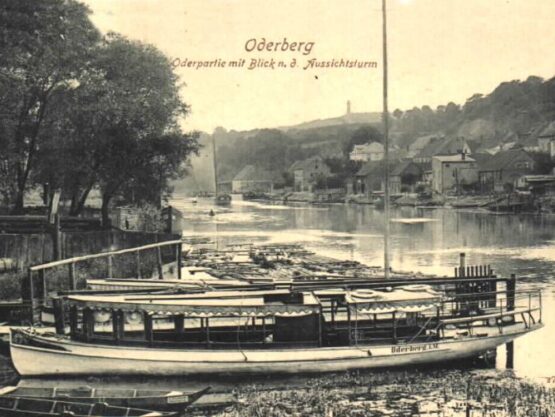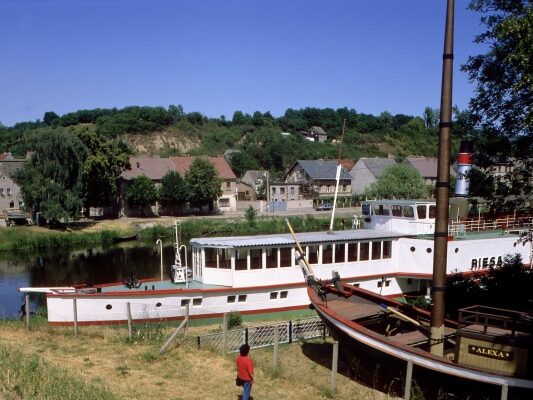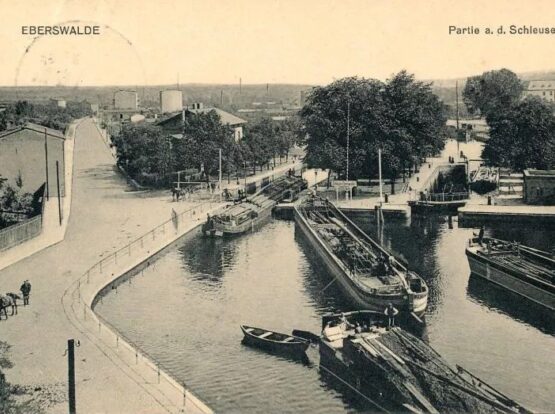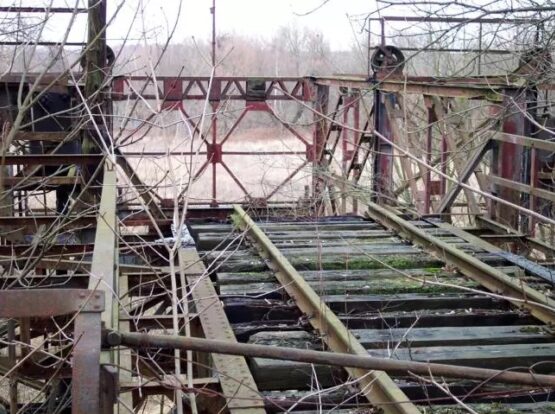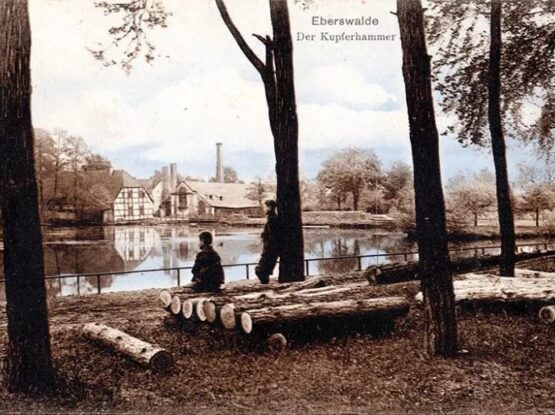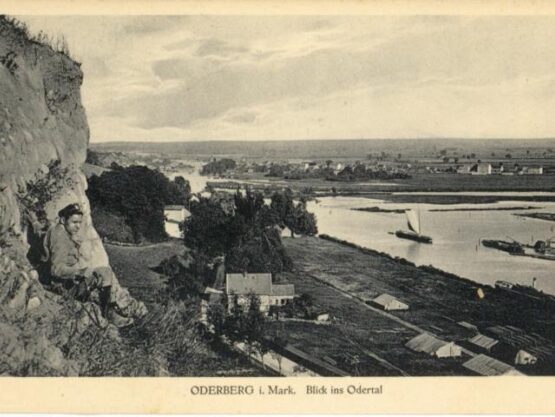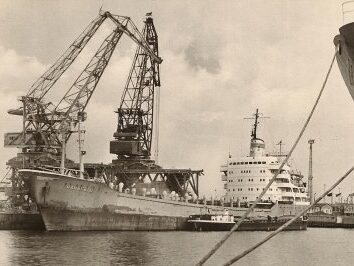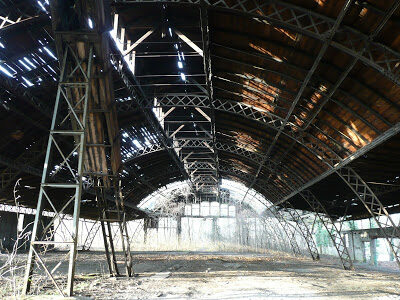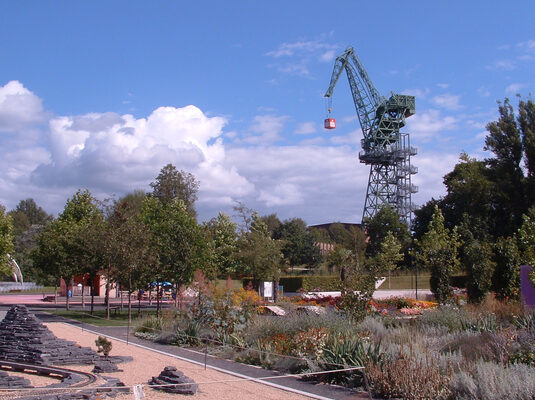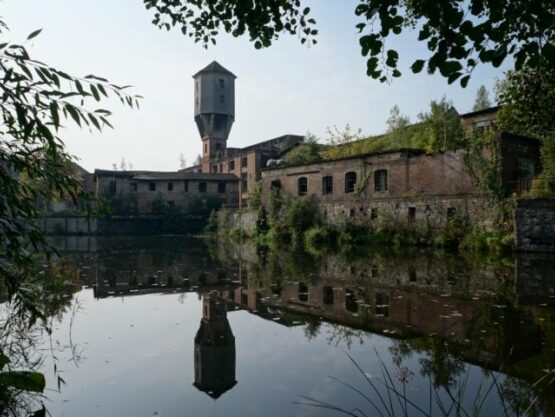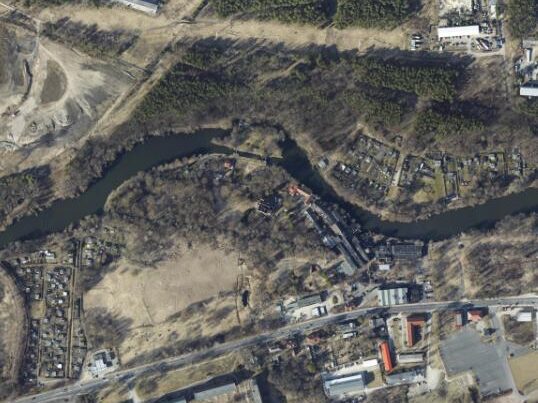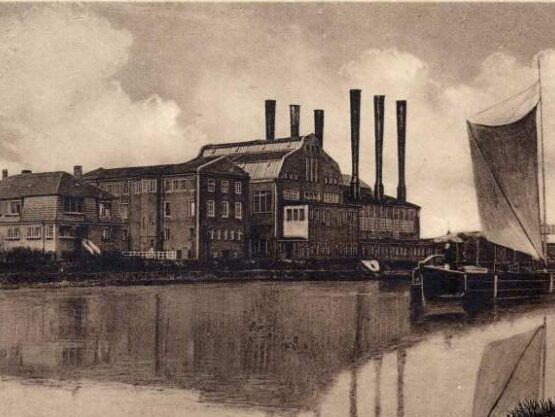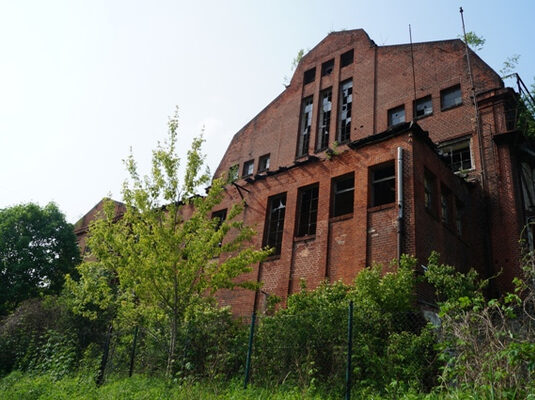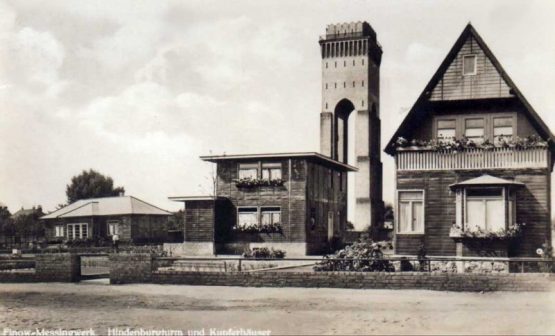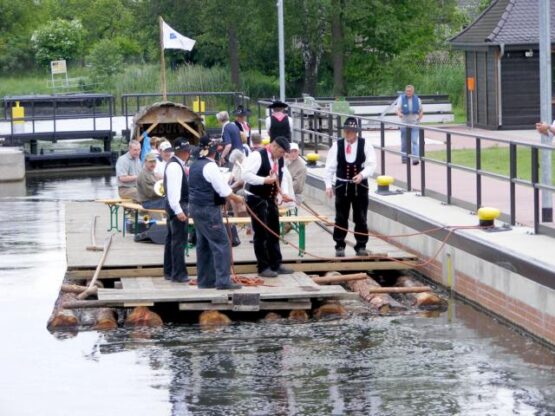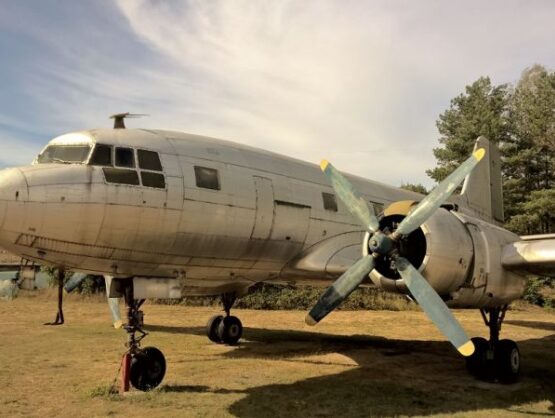Finowkanal Industrial Heritage
Welcome!
This tour takes you to the most important sites in Brandenburg’s industrial history, along Germany’s oldest man-made waterway. You can cover the route on foot, or go on a more extended bike tour along the towpath beside the canal. The bike route starts in Ruhlsdorf/Marienwerder and ends in Niederfinow (total distance: 35.5 kilometres).
On the map in this app – and in the blue menu – you’ll find all the stops on this tour, plus information about the museums and interesting sights along the Finow Canal. But first of all, listen to a recording about the history of the Finow Canal to get in the mood for your journey of discovery.
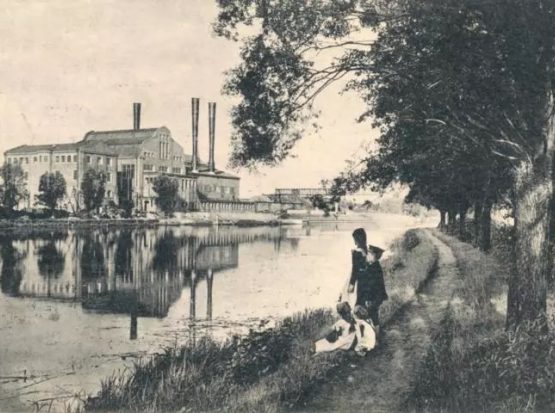
A Liebenwalde
Construction of the first Finow Canal began in 1605, below Liebenwalde. The canal quickly became an important lifeline for the small farming town. As the shipping industry began to grow, industrial companies started to base themselves here. In 1924/1925 the Zerpenschleuse lock was filled in, and it was no longer possible to navigate the canal continuously as far as Liebenwalde.
But the townscape always remained characterised by agriculture, and visitors will still find a typical Brandenburg farming town here nowadays. The inhabitants used to be known as ‘Ackerbürger’, which means ‘land-cultivating townspeople’. It referred to their main activity: agriculture. Unlike the farmers in the villages, the ‘Ackerbürger’ were free citizens who practised both crafts and agriculture.
The Heimatmuseum Liebenwalde (museum of local history) is housed in the former town jail, just behind the town hall. You’ll find information about shipping there, with a focus on the Finow Canal, and the history of the town of Liebenwalde. An ‘authentic’ jail cell has also been preserved.
Heimatmuseum Liebenwalde (museum of local history)
Overview
B Eberswalde
Since 1997 the local Eberswalde museum and the tourist information office have been housed in what used to be the Adler Pharmacy. It is the town’s oldest remaining half-timbered house and was built in 1663. It has since been restored and is now one of the most attractive historical buildings in the old town centre.
The museum’s collection of artefacts from the town and the region has grown over the past 110 years to include exhibits that bear witness to the industrial and technological developments in the Finow Valley. There is a room dedicated to the Experimental Radio Station Eberswalde and its legendary music transmissions – an important chapter in the early history of German radio.
Further sights in the town include the Paul Wunderlich House and the impressive Marienkirche church. It is also worth taking a trolley bus through Eberswalde. These electric buses have served the Finow Valley since 1940, when they replaced trams. A rare sight in Germany today, the trolley bus is still the main form of public transport in Eberswalde.
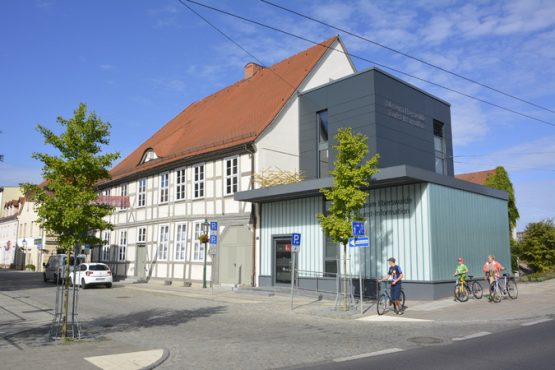
Museum Eberswalde
Overview
C Niederfinow
By the late 19th century the Finow Canal was barely able to cope with the increased volume of traffic. Consequently, the Prussian government decided to build a shipping lane for large ships between Berlin and Szczecin in 1905. Between 1906 and 1914 the Hohenzollern Canal (now called the Oder-Havel Canal) was built. Situated to the north of the Finow Canal, it now comprised a second route from the River Oder to the River Havel, for larger ships. New, interesting technical features were built here, such as the hydraulic structure known as the ‘Brückenkanal’, which crossed the Berlin-Szczecin railway line, and the Ragöser Dam – the world’s highest canal dam at the time, at 28 metres. Near Niederfinow, alongside the staircase lock, the famous ship lift was erected between 1926 and 1934. Kurt Plarre, a government building officer at the Eberswalde Office for New Development (in the ‘Reichswasserstraßenverwaltung’), was responsible for the planning. The lift made it possible to overcome a 36-metre height difference in just five minutes. It held the record for the world’s highest ship lift until a higher lift was built near Lünenburg in 1976.
In 2006 construction work began on the new Niederfinow Nord ship lift. It will eliminate a considerable bottleneck on the only trans-European East-West waterway link between Szczecin and Duisburg (via Berlin, Magdeburg, Hanover and Münster). After the project has been completed, the Berlin-Szczecin route will also be able to compete for container transport by water. The Niederfinow Nord ship lift is being constructed out of reinforced concrete. It will be a vertical lift with counterweights, just like the current lift. The trough will be 125.5 metres long, 27.9 metres wide and four metres deep and, when filled with water, it will weigh 9,800 tonnes. The estimated cost of the project is €285 million. Completion is planned for 2025.
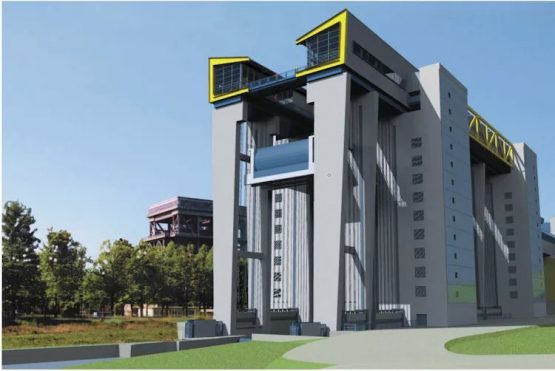
Schiffshebewerk Niederfinow (Niederfinow ship lift)
Overview
D Oderberg
Oderberg marks the end of the Finow Canal – this is where it reaches the River Oder, which leads to the Baltic Sea. The museum in Oderberg offers interesting insights into the history of inland waterway transport and fisheries. The developments that took place over the centuries are brought to life by various model ships – from the wooden ‘Kaffenkahn’ barge with sails, to the steam tug, to the modern diesel-powered pusher unit. The museum also traces the development of the waterways and their engineering works. An entire floor of the museum is dedicated to Oderberg’s fishing tradition, which is almost 1,000 years old. In the Middle Ages there were 36 families of fishermen here.
But the most well-known exhibit is the former luxury paddle steamer ‘Riesa’, built in 1897 and used on the River Elbe until 1976. In 1901 she carried the Emperor of Austria across the Elbe. You can see the steam engine up close from inside. In the outdoor area, further interesting vessels and ship engines are on display.
Binnenschifffahrts-Museum Oderberg (Oderberg inland waterway transport museum)
Overview
First Stop
Town lock
Twelve historical locks can still be visited along the Finow Canal, but the town lock (‘Stadtschleuse’), built in 1831 and modernised from 2000 to 2001, is the oldest lock still in operation between the Elbe and Oder rivers. The locks of the Finow Canal, rebuilt in the 19th century, could take two ships simultaneously. This meant that the entries and exits were now no longer situated at the centre – they were at the sides instead. These locks were adapted to a new kind of ship: the ‘Finowmaßkahn’, whose maximum size was determined by a royal order in 1845.
To the right and left of the canal, towpaths can still be made out in some places today. Towing was done by horses. They pulled the ships – which did not have engines until the 19th century – upriver. This was a lengthy and monotonous business that was only interrupted when the horses were occasionally moved to the other side.
Overview
Second Stop
Horseshoe Nail Factory
After crossing the railway tracks, it’s a short walk to the former horseshoe nail factory owned by Moeller & Schreiber. The boiler house with its high chimney (1882) and the late-classical manufacturer’s villa (1873) on Kupferhammerweg bear witness to the factory, which moved from Berlin to Eberswalde in 1871 and whose founder invented a machine for the industrial production of horseshoe nails.
A unique technological monument at this site is the wagon lift constructed by the Berlin-based company Borsigwerke. From 1908 onwards, an electrohydraulic lifting device transported loaded goods wagons from the factory premises to the railway siding. The lift has since fallen into ruin.
Overview
Third Stop
Kupferhammer
The relocation of two hammer mills from the Schwärze River (Kienwerder) gave rise to the first industrial settlement in the Finow Valley in 1603. Alongside the ‘Hüttenamt’ – an office building constructed in 1776 with a facade design that was originally baroque – the classical-style factory buildings and residential buildings still feature prominently today.
The copper-rolling mill erected in Britzer Straße by the Prussian government between 1816 and 1818 is one of Brandenburg’s most important examples of early industrial architecture. The officials responsible for the project had visited modern iron and steel works in England beforehand. The architectural design was done by Johann Friedrich Wedding, a leading industrial architect. He also planned the ironworks in Gleiwitz and Königshütte, so he had an excellent reputation that extended far beyond the borders of Prussia. Close to the rolling mill, three residential buildings that were constructed for workers’ families in 1818, 1830 and 1833 are still standing. The stone wall used to border the settlement of Kupferhammer.
Overview
Fourth Stop
Crane Construction
The Ardelt works, located at Heegermühler Straße from 1912 onwards, became known around the world for crane construction. After the Second World War, the public enterprise VEB Kranbau Eberswalde continued this tradition, specialising in the manufacture of port and shipyard cranes.
One of the industrial landmarks of the Finow Valley is the assembly crane ‘Eber’, erected in 1954. Although no longer in operation, it was restored for the ‘Landesgartenschau’ horticultural show, and a viewing platform was added. It provides a beautiful panoramic view across Eberswalde.
Overview
Fivth Stop
Eisenspalterei Family Garden
South of the Drahthammerschleuse lock (and the Schleusenkrug restaurant in the former lock operator’s house) is the ‘Eisenspalterei’ plant, founded in 1698 by the Huguenot Moise Aureillon. Its name refers to a plant in which rolled iron was cut for further processing.
The scholar Johann Joachim Bellermann noted in his 1829 travel guide that bathers would regularly come on foot and by wagon to the area due to its “romantic situation and various technical curiosities”.
In 2002 the site hosted Brandenburg’s second ‘Landesgartenschau’ horticultural show. This filled the industrial site – unused since 1992 – with new life. The iron-rolling mill, with its classical facades – built between 1816 and 1818 and modelled on English mills – was redeveloped. This is where the painter Carl Blechen found the subject for his painting The Neustadt-Eberswalde Rolling Mill in 1830. It was one of the earliest depictions of industry in German art history.
In the neighbouring new rolling mill (1895-1897), a large flywheel from a steam engine has been preserved. A pedal-boat ride through the mill’s underground channels offers an unforgettable experience. The iron hall west of Lichterfelder Straße was originally a prototype for an unsupported, easily expandable construction. It was built by the Borsigwerke company in Berlin-Moabit between 1847 and 1849. A model for many station concourses and factory and exhibition halls, it was dismantled in 1900 and moved to its current location on the Finow Canal.
Familiengarten Eberswalde (Eberswalde family garden)
Overview
Sixth Stop
Chemical Plant
From the towpath, two parts of the former chemical plant now come into view: the administrative building (1899-1900) and a building used by officials and factory workers (1900).
The plant was founded in 1894 as a linoleum factory and experienced a boom after it was taken over by the company Chemische Fabrik auf Actien (formerly E. Schering), Berlin in 1921. Two years later, production of synthetic camphor began in an older factory building. The product was in high demand in the pharmaceutical industry and, above all, as a softening agent for celluloid.
After the war, the factory was expropriated and dismantled, but in 1951 it was able to reopen under the name VEB Chemische Fabrik Finowtal and resume production of camphor and fragrances. In 1968 it started to produce cellulose derivates as well, and it grew considerably.
In 1991 the old camphor factory was shut down and sold to the town of Eberswalde, which demolished the building between 1998 and 1999 to make way for a car park.
The remaining part of the factory – which focused on cellulose chemistry – went bankrupt in the mid-1990s and was also torn down.
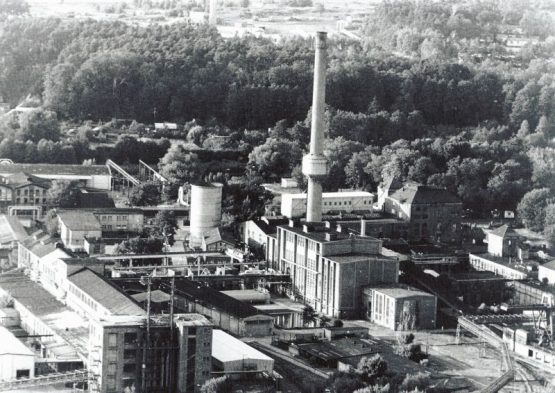
Overview
Seventh Stop
Wolfswinkel Paper Factory
The Wolfswinkel paper factory, founded in 1762, houses a first-class monument to technological development: the production department for handmade paper, which is still functional today. The installations were originally located in the Spechthausen paper factory, founded in 1781 south of Eberswalde. After this factory was shut down, they were integrated into the Wolfswinkel plant between 1956 and 1957. They include two Hollander beaters, in which the raw material is milled and mixed, three tiled vats, cast-iron presses and a calender for smoothing the finished sheets.
There are signs of the sweeping modernisation of the 1920s here, particularly in the water tower and the paper machinery hall, which was built under the direction of the Siemens architect Hans Hertlein between 1928 and 1929. The Berlin-based company Siemens-Schuckertwerke bought the Wolfswinkel paper factory in 1917 and manufactured cable paper and insulation paper there.
Overview
Eigth Stop
Heegermühle Power Station
One of the most impressive industrial monuments in the Finow Valley is the MEW (‘Märkische Elektricitätswerk’) power station, built in 1909. This installation was designed by the engineer Georg Klingenberg, who established a new theory of power station construction while working at the Royal Technical Higher School of Berlin. The power station supplied broad swathes of the northern part of Brandenburg with electricity. It was long considered a representative installation, serving as a model for numerous power stations at home and abroad.
The MEW was also a progressive building in terms of aesthetics. Klingenberg criticised the eclecticism of the imperial age, which not only typified most of the residential and commercial buildings, but also concealed technical installations behind faux-historical decorative facades. “The architectural design of electric power stations has, many times over, followed the wrong path, and the natural requirement that the design take into account the purpose of the building has rarely been fulfilled so far.”
The facades were designed by the architect Werner Issel to be functional, and were faced with red bricks. Together with the light-filled interior, they make the power station an outstanding example of the efforts to reform architecture in the early 20th century. The representative facade faces towards the canal. The placement of the individual buildings – the boiler house on the right (originally towered over by several chimneys), the machinery hall with its steam turbines in the middle, and the control centre on the left – reflects the operational sequences that were followed inside.
Overview
Ninth Stop
Messingwerk
From 1698 to 1700 Brandenburg’s first brass works was erected near the village of Heegermühle. Between 1721 and 1725 it was moved upriver to its final location. In 1863 the Halberstadt-based company Aron Hirsch & Sohn purchased the state-owned enterprise. This Jewish family of business owners also left their mark on the social life of the area.
On 16 May 1913 excavation work here led to a sensational discovery: the Bronze-Age ‘Treasure of Eberswalde’, which is still the most significant of its kind in central Europe today. There are copies at the Eberswalde Museum in the Adler Pharmacy and at the Museum of Prehistory and Early History in Berlin.
In 1920 the new factory in Messingwerk commenced operation. It was designed by the engineer Georg Schlesinger, an expert in rationalising production processes who held the first German chair for Machine Tools and Factory Management at the Technical University of Berlin between 1904 and 1933.
Overview
Tenth Stop
Finowfurt
The district of Finowfurt in the municipality of Schorfheide forms the western edge of the urban belt in the Finow Valley. The premises of the former mill (built in 1900) to the south of the Schöpfurth lock (built 1875–1876) are a good example of the regeneration of an inactive industrial centre.
Timber rafting has been one of the most important forms of transport ever since the canal was built. The rafts were usually poled, but also towed, and if the wind conditions were good, a small sail could be set. Later on, tugs pulled up to ten rafts behind them. Dozens of sawmills and timber-rafting businesses emerged. By the mid-19th-century, a lot more wood was arriving at the river Oder in Hohensaaten than could be transported to the west. As a result, the Oderberger Lake and the Lieper Lake became giant storage depots for timber.
The Rafting Festival held every year in Finowfurt commemorates this tradition. Since 2000 the ‘Schippelschute’, a raft built especially for passenger transport, has carried day trippers along the Finow Canal.
In 1993 the CIS air corps left the Finow airfield. Nowadays the aviation museum provides information about the history of aviation in Brandenburg. Special attractions include around 25 original planes from the period 1945–1985. The museum also features historical vehicles from the period 1942–1960, models and many other exhibits.
Luftfahrtmuseum Finowfurt (Finowfurt aviation museum)
Overview
© 2022 | Unser Finowkanal e.V.
